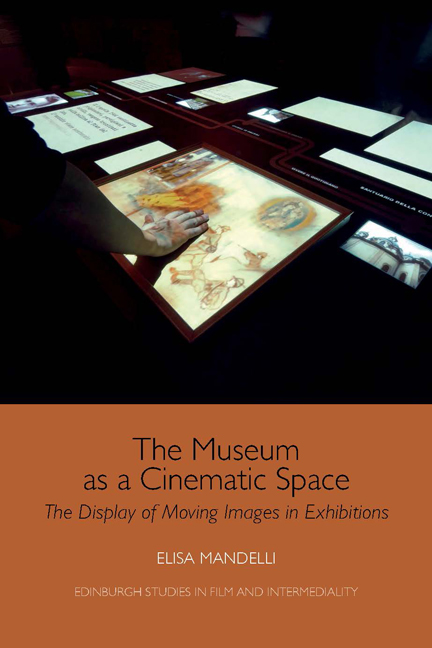Book contents
- Frontmatter
- Contents
- List of Figures
- Acknowledgements
- Preface
- Introduction
- Part I Between History and Modernity: Films in Exhibitions in the Twentieth Century
- 1 Cinema, Museums, Memory and Education
- 2 ‘A dimly-lighted corner’: Moving Images in Museums in the First Decades of the Twentieth Century
- 3 Moving Images in Museums, World's Fairs and Avant-garde Exhibition Design
- 4 The Multi-media Museum: The 1960s–70s
- Part II The Museum as a Cinematic Space: Museums and Moving Images in the Twenty-first Century
- Conclusions
- Bibliography
- Index
4 - The Multi-media Museum: The 1960s–70s
from Part I - Between History and Modernity: Films in Exhibitions in the Twentieth Century
Published online by Cambridge University Press: 24 October 2019
- Frontmatter
- Contents
- List of Figures
- Acknowledgements
- Preface
- Introduction
- Part I Between History and Modernity: Films in Exhibitions in the Twentieth Century
- 1 Cinema, Museums, Memory and Education
- 2 ‘A dimly-lighted corner’: Moving Images in Museums in the First Decades of the Twentieth Century
- 3 Moving Images in Museums, World's Fairs and Avant-garde Exhibition Design
- 4 The Multi-media Museum: The 1960s–70s
- Part II The Museum as a Cinematic Space: Museums and Moving Images in the Twenty-first Century
- Conclusions
- Bibliography
- Index
Summary
MUSEUMS AND FILMS FROM UNESCO TO WORLD'S FAIRS
Some of the activities promoted from 1958 to 1962 by UNESCO and the International Council of Museums (ICOM), the worldwide association of museum professionals founded in 1946, testify to the growing importance of films and audio-visuals in museums. This question was discussed during a conference of ‘Museum, Film and Television Experts’, held on 8–11 July 1958 at the United Nations Pavilion of the Brussels International Exhibition. In those years, museums had become fully conscious of their educational role, and were directing their efforts towards finding new and more effective ways to communicate with the public. The inspiring idea was that museums should not be considered only repositories of antiquities, but living organisms able to reach the public with modern appealing methods. One of the pivotal ideas of the seminar was that both film and television ‘are destined, especially so far as their cultural programs are concerned, to exercise an increasing influence in the realm of museums’. In this view, both media would help museums stay up to date and reach out to a wider audience.
The main goal of the conference was to increase awareness about technical issues and to promote collaboration between museum professionals and film and television producers. Experts from both fields discussed how film and television could serve the museum as a whole, addressing topics such as the relationship between original works of art and their audio-visual representation, as well as the forms and contents of films and programmes for museums. As a confirmation of the effectiveness of audio-visual communication for museums, the film Museum of Art, which presented works from twenty American art museums, was shown at the American Pavilion of the Exhibition.
A few months later, at the 1958 UNESCO Regional Seminar on the Educational Role of Museums in Rio de Janeiro, museum professionals recognised that films and television were museums’ richest educational means, as they could be effectively employed in different ways. According to the seminar report, films could be used at the beginning of guided tours, ‘to prepare members of the group for the tour, by the use of different methods than those used in the museum display’.
- Type
- Chapter
- Information
- The Museum as a Cinematic SpaceThe Display of Moving Images in Exhibitions, pp. 61 - 70Publisher: Edinburgh University PressPrint publication year: 2019



